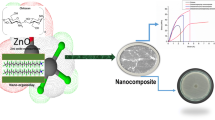Abstract
Chitosan/clay (nano)composites were prepared by using a special quaternary ammonium intercalating agent coupled with a silanol group to facilitate the organic clay formation. Exfoliated clay in the chitosan matrix was attained at the higher intercalant dosages through X-ray diffraction (XRD) and transmission electron microscope (TEM) analyses. Optical transmittance for the (nano)composites increased slightly with increasing the amount of intercalants in the clays. In light of the hydrophobic component on the intercalant and the effective clay content, the interfacial interaction between chitosan and modified clay may not be strong enough to render higher mechanical properties, even though the partially exfoliated clays were achieved to provide high interfacial area for the dispersed phase and the matrix. An optimum Young’s modulus was thus found for (nano)composites using modified clay at a medium dosage of intercalant, which resulted from the balance of the dispersion status and interfacial interaction. This outcome indicated high dispersion of modified clay may not guarantee high mechanical properties of (nano)composites. The antimicrobial property of chitosan against Escherichia coli (E. coli) increased further with the addition of modified clays, in which the intercalant exhibiting the antimicrobial function. The modified clay at an optimum dosage of modifier to balance the mechanical properties and antimicrobial property was attained.








Similar content being viewed by others
References
As’habi L, Jafari SH, Khonakdar HA, Baghaei B (2011) J Polym Res 18:197–205
Arora A, Choudhary V, Sharma DK (2011) J Polym Res 18:843–857
Tunc S, Duman O (2010) Appl Clay Sci 48:414–424
Tunc S, Duman O (2011) LWT-Food Sci Technol 44:465–472
Rao YQ (2007) Polymer 48:5369–5375
Tunc S, Angellier H, Cahyana Y, Chalier P, Gontard N, Gastaldi E (2007) J Membrane Sci 289:159–168
Kweon D-K, Cha D-S, Park H-J, Lim S-T (2007) J Appl Polym Sci 78:986–993
Darder M, Colilla M, Ruiz-Hitzky E (2003) Chem Mater 15:3774–3780
Wang X, Du Y, Yang J, Wang X, Shi X, Hu Y (2006) Polymer 47:6738–6744
Han Y-S, Lee S-H, Choi KH, Park I (2010) J Phys Chem Solids 71:464–467
Wang X, Du Y, Yang J, Tang Y, Luo J (2008) J Biomed Mater Res 84A:384–390
Ngah WSW, Teong LC, Hanafiah MAKM (2011) Carbohydr Polym 83:1446–1456
Xu Y, Ren X, Hanna MA (2006) J Appl Polym Sci 99:1684–1691
Tan W, Zhang Y, Szeto YS, Liao L (2008) Comp Sci Technol 68:2917–2921
Tang C, Chen N, Zhang Q, Wang K, Fu Q, Zhang X (2009) Polym Degrad Stab 94:124–131
Szazdi L, Pukanszky JB, Vancso GJ, Pukanszky B (2006) Polymer 47:4638–4648
Lai S-M, Chen C-M (2007) Eur Polym J 43:2254–2264
Chen W-C, Lai S-M, Chen C-M (2008) Polym Int 57:515–522
Ray SS, Okamoto M (2003) Prog Polym Sci 28:1539–1641
ASTM D638-08 Standard Test Method for Tensile Properties of Plastics (2009) Annual Book of ASTM Standards 08.01:50–65
ASTM E2149-01 Standard Test Method for Determining the Antimicrobial Activity of Immobilized Antimicrobial Agents Under Dynamic Contact Conditions (2009) Annual Book of ASTM Standards 11.05:673–676
Gunister E, Pestreli D, Unlu CH, Atici O, Gungor N (2007) Carbohydr Polym 67:358–365
Liao H-T, Wu C-S (2005) J Appl Polym Sci 97:397–404
Chen P, Zhang L (2006) Biomacromolecules 7:1700–1706
Martucci JF, Ruseckaite RA (2010) Polym-Plast Technol Eng 49:581–588
Wang SF, Shen L, Tong YJ, Chen L, Phang IY, Lim PQ, Liu TX (2005) Polym Degrad Stab 90:123–131
Zheng JP, Li P, Ma YL, Yao KD (2002) J Appl Polym Sci 86:1189–1194
Martucci JF, Vazquez A, Ruseckaite RA (2007) J Therm Anal Calorim 89:117–122
Wang S, Zhang Y, Ren W, Zhang Y, Lin H (2005) Polym Test 24:766–774
Deng Y, Gu A, Fang Z (2004) Polym Int 53:85–91
Lai S-M, Ti K-T (2007) Int Polym Process 12:502–511
De Britto D, Campana-Filho SP (2004) Polym Degrad Stab 84:353–361
Lai S-M, Yang AJ-M, Chen W-C, Hsiao JF (2006) Polym-Plast Technol Eng 45:997–1003
Rhim J-W, Hong S-K, Park H-M, Ng PKW (2006) J Agric Food Chem 54:5814–5822
Callister Jr WD (2006) Materials science and engineering, an introduction, 7th edition; Chap. 8, Wiley
Fornes TD, Paul DR (2003) Polymer 44:4993–5013
Acknowledgments
The grant-in-aid from R.O.C government under NSC 95-2622-E-197-005-CC3 is greatly acknowledged. Financial support from Taiwan surfactant is acknowledged. Helpful discussions on TEM discussion from Prof. J.-Y. Lai and Dr. Y.-H. Su in Chung-Yuan Christian University and on clay modification procedure from Prof. C.-S. Wu at the Department of Chemical and Biochemical Engineering, Kao Yun University, TAIWAN are greatly appreciated. We are also grateful to Prof. Li-Chien Chang at School of Pharmacy, National Defense Medical Center, Taiwan for his discussion on antimicrobial properties.
Author information
Authors and Affiliations
Corresponding author
Rights and permissions
About this article
Cite this article
Chiu, FC., Lai, SM., Hsieh, IC. et al. Preparation and properties of chitosan/clay (nano)composites: a silanol quaternary ammonium intercalated clay. J Polym Res 19, 9781 (2012). https://doi.org/10.1007/s10965-011-9781-5
Received:
Accepted:
Published:
DOI: https://doi.org/10.1007/s10965-011-9781-5




